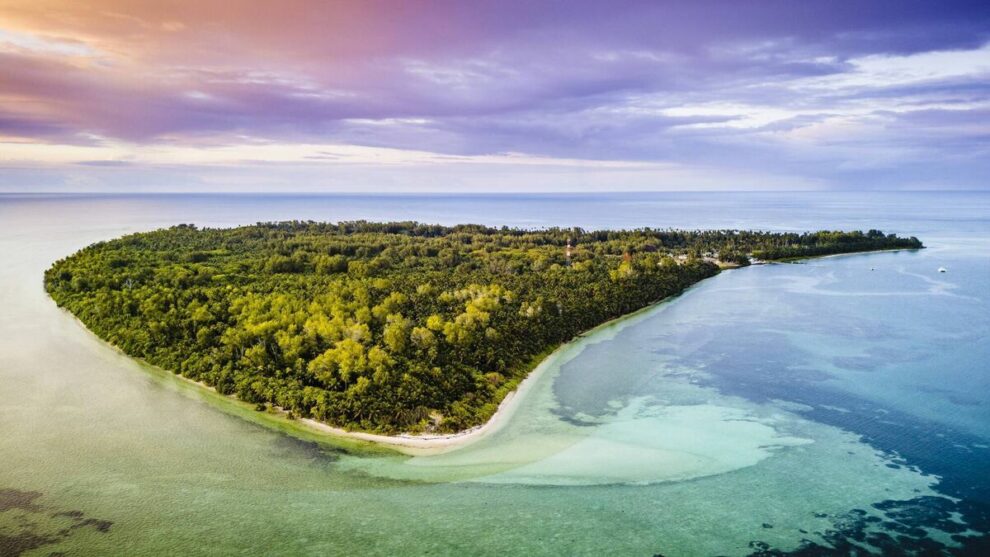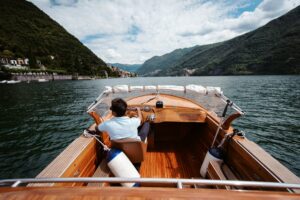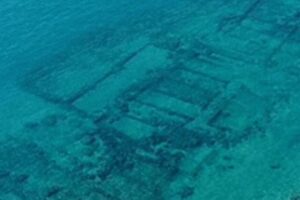Time works differently in paradise. Days are measured in dives and tides, sundowners and dawn dips.
It’s only Day 1 on Alphonse Island, but I feel like I’ve been here much longer.
My home for the next six days is an eco-beach bungalow on one of three teeny-tiny tropical islands tucked away in the Indian ocean, about 400km southwest of the Seychelles island group.
To add to the adventure of it all, to get to be a guest at Blue Safari’s singular resort on Alphonse, I board a 14-seater sea plane from Mahé — how thrilling!
As the wing dips over an impossibly-perfect azure sea, and we land on a tiny airstrip slashed into a dense tropical forest, I can feel myself decompress.
I take my first step on Alphonse soil, breathe in the soft warm air, and flick the switch to island time.
Of course, Alphonse isn’t any old island.
This Lilliputian slice of heaven is all about experiential eco-tourism, so think barefoot luxury, with a massive emphasis on protecting and preserving the unique ecosystem and natural resources here.
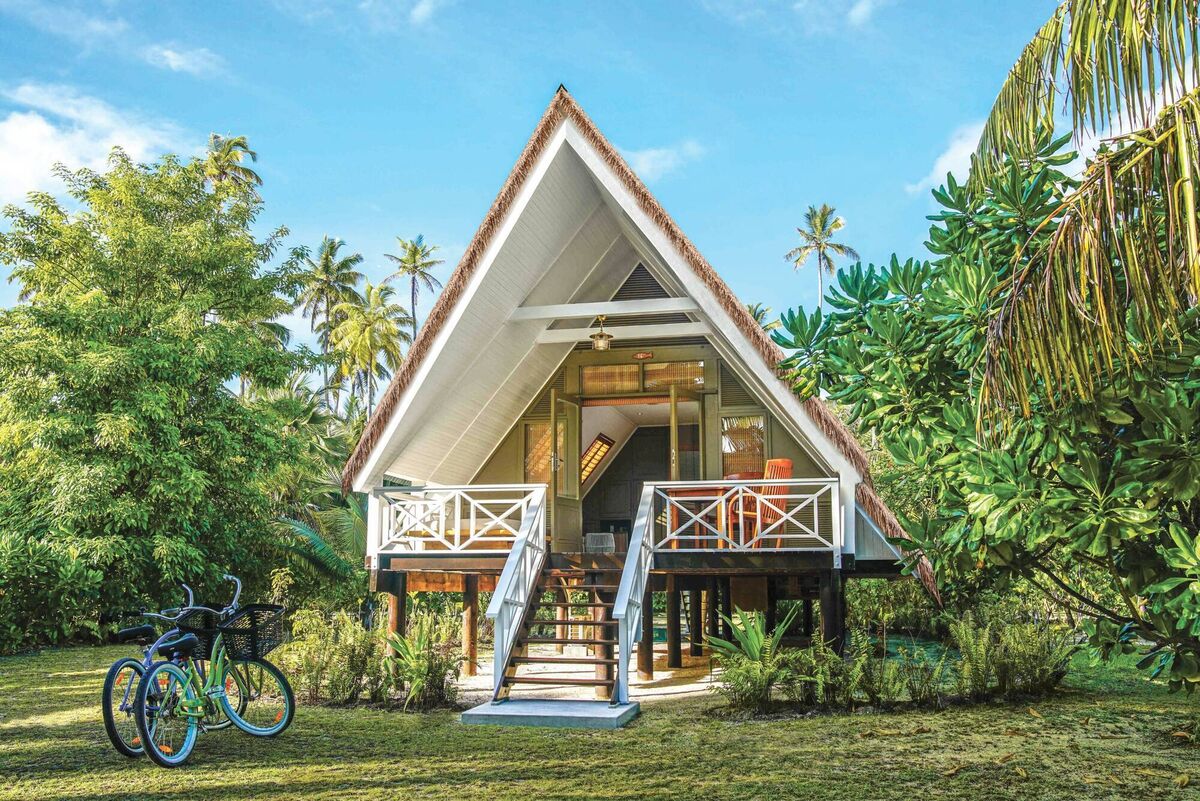
Island life means waking up in my beach bungalow, beautifully crafted, with a private deck looking out to a sea view fringed with swaying greenery, with herons tiptoeing about, and red-footed booby birds swooping above. The lodges are a clever mix of simplicity with hat tips to luxe living.
A simple bamboo-shrouded outdoor shower, where darting geckos and a sky full of birds keep you company, is countered with a deep, decadent sunken bath in the spacious bathroom inside.
There’s not a single-use plastic to be found, and everything you could possibly need is provided in your room — from organic toiletries to homemade sweet treats to go with your fresh coffee, to umbrellas (for shade rather than rain, I imagine), to insect repellent, and large beach bags.
There’s even a red light on the beach side of the bungalow, as white lights can disrupt the resident turtles when they’re nesting. They’ve really thought of everything. There’s a turn down service every evening, with chocolates and a little card giving you little nuggets of information about the island.
“Did you know”, my card asks me on my first night, “the bumphead parrotfish has incredibly strong teeth which can crush coral? The coral passes through the fish and fine white sand comes out of the other end as ‘poo’. A bumphead parrotfish can produce 400kg of sand per year. Remember that when you are lying on the beach.”
It’ll take more than fish faeces to keep me off that stunning strand, but nice try.
SPEAKING of beaches, I’m given my own snorkel, mask, and flippers to keep for my stay, so who’s up for a spot of snorkelling?
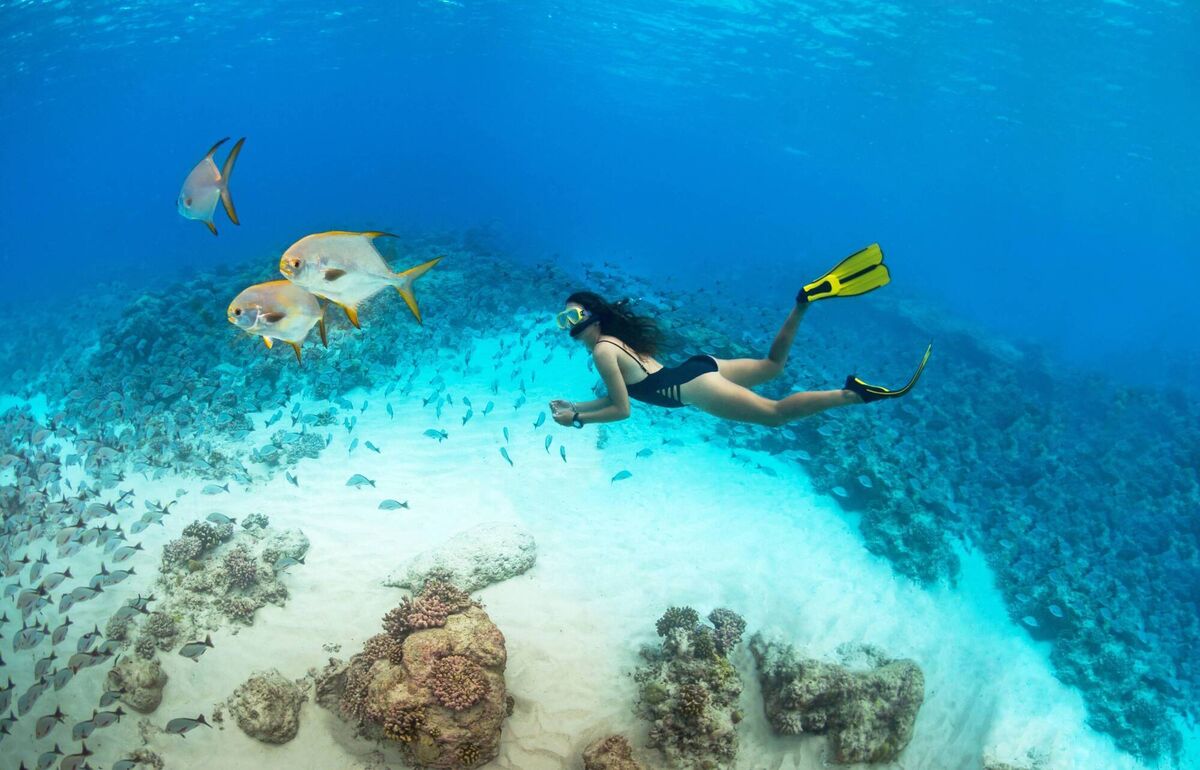
Every guest gets a bicycle with a big basket and back pedal brake (great craic after a couple of espresso martinis, let me tell you) to get around the island — it’s small enough to explore in its entirety on two wheels — with handmade posts with signs to keep you on the right track.
I cycle leisurely past my very favourite sign, the Tortoise Nursery (yes, it’s as adorable as it sounds), to the activity centre where Jason from South Africa and Josh from the Eastern Cape, along with resident marine biologist Elle, are getting everyone ready for the eponymous Blue Safari ocean expedition.
They run through the safety talk and we follow them along the bouncing jetty to where the magnificent St Francoise catamaran is waiting.
Elle explains that this group of atolls, with its particular currents, healthy coral, and excellent visibility create ideal snorkelling conditions.
Josh finds a good spot and the group slips into the welcoming water (some of us more gracefully than others, cough).
I duck under and the world below is an explosion of colour and motion. We stick together, flicking our fins, methodical and mellow, keeping an eye on our leader, as we weave past colourful coral, dancing sea branches, and busy reef fish going about their business.
A rather tetchy looking hawksbill turtle meanders below us, nearly close enough for us to touch his hopscotch shell. Delighted, we push past milk fish and an ethereal manta ray. Josh dives deeper and points out butterfly fish and a school of bluestripe snapper.
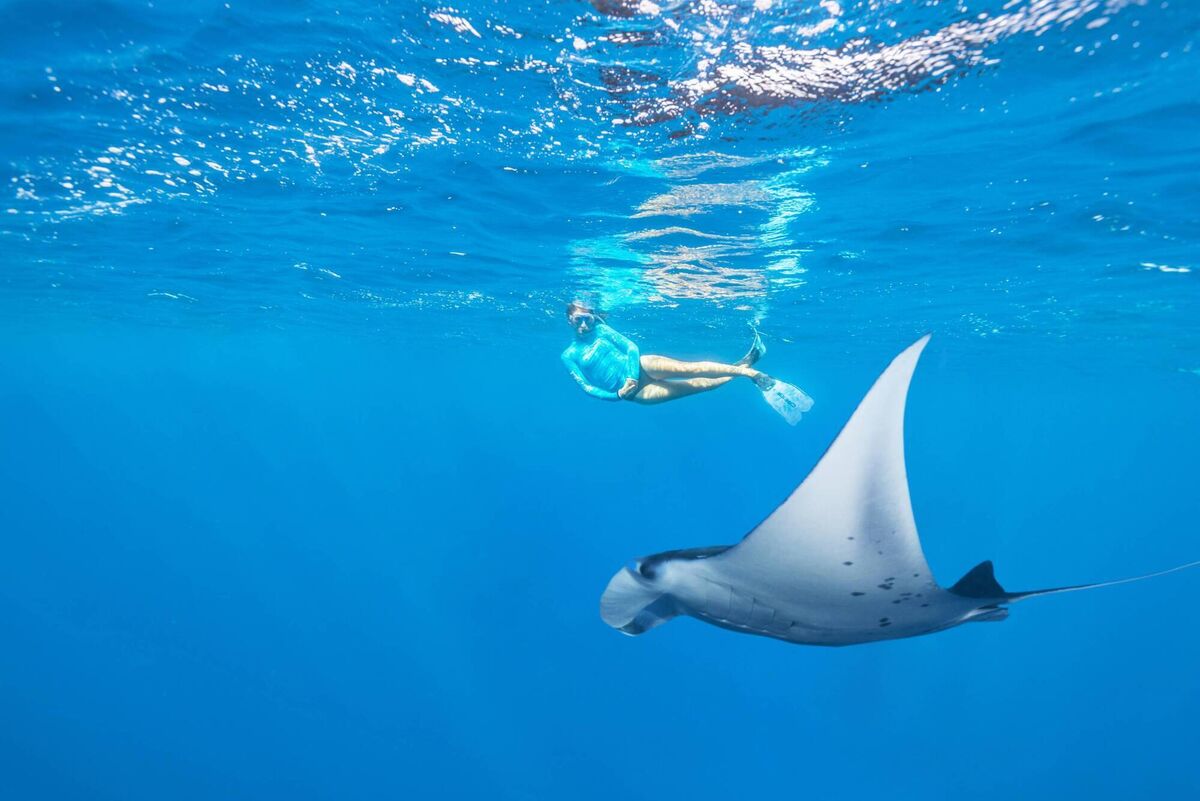
Because it’s a lagoon, it feels safe to explore — even though it seems like I’m hanging on the edge of an upside-down cliff — and it’s such a privilege to be so utterly immersed in this mystical world. The marine magic weaves its spell, and when we haul ourselves back on board everyone is buzzing with delight.
On the way back, we spot a humpback whale and a surprise school of spinner dolphins, a big pod, who chase and play with the boat, cheeky chaperones bringing us safely on our way.
Elle points out the little pink ones: They’re the babies. Gah! The cuteness!
With the swell and wind behind us, we cruise east, coming around the lee of the island to finish off the trip with a snorkel. A dream day.
Another bunch of island hours is taken up with a fly-fishing expedition, and I catch a Wahoo fish.
I can’t really type this with a straight face, as the marvellous Kazongo from Kenya does all the hard work; I just reel it in and get the glory and pose for the photos.
The imposter guilt doesn’t stop me from taking part in the bell ringing ceremony though.
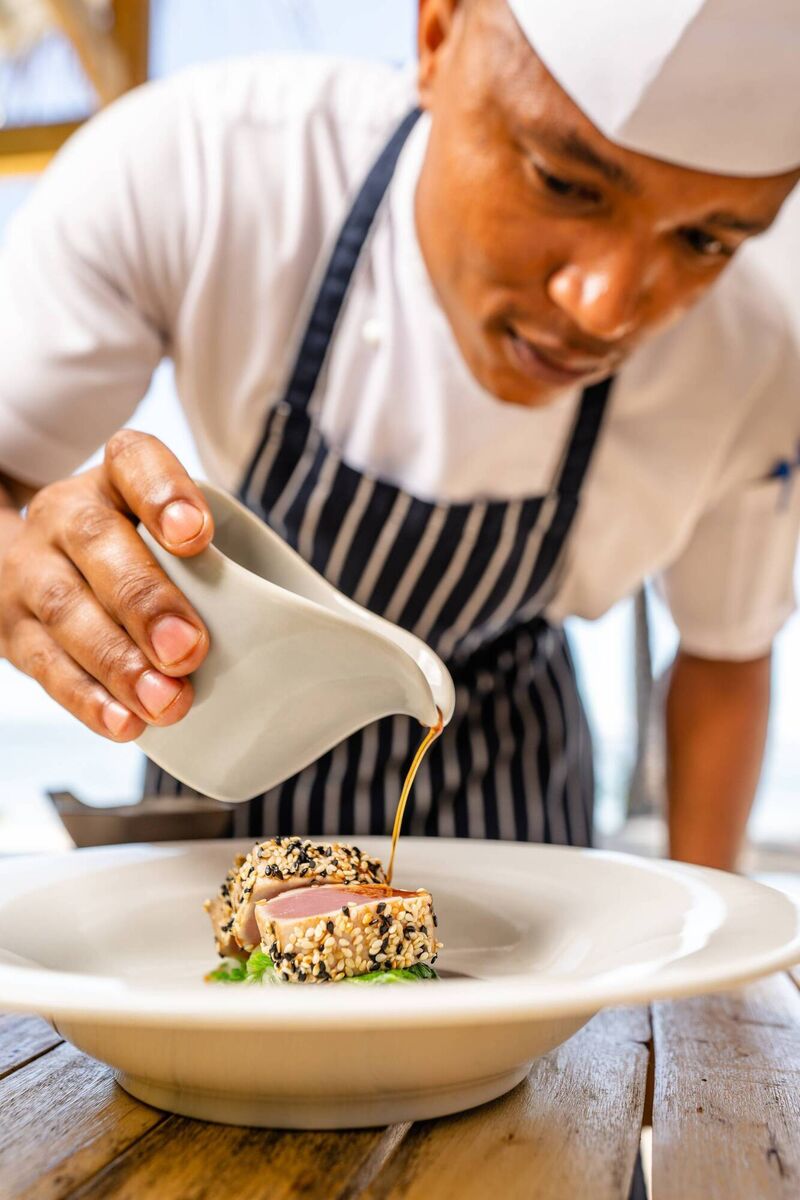
The resort is renowned for its fishing, adopting a catch and release system. So there’s lots of fishermen and fisherwomen around the bar in the evenings talking about bait and lines and gesticulating wildly.
Catching a Giant Trevally is what the serious guys and gals are here for — apparently the massive fish are extremely powerful, fearsome, and don’t give up without a hell of a fight.
It’s customary every night in the bar, just before dinner, for one of the staff to call out a fisher who has done particularly well that day, and they come up and ring a bell and drink a shot.
It’s all very civilised. Until a Cork journalist gets on the scorecard. In hindsight, insisting on making a speech and thanking God and my parents was a bit much and, if I had my time back, I would probably only have sung one verse of “The Banks of My Own Lovely Lee”. Thanks must go to the bemused Jarod for shoving me gently back to my seat, while expertly wrestling the bottle of tequila out of my hand.
His many years of experience with Giant Trevally served him well that night.
And so, like all good things, my time in paradise must come to an end. Moments and memories to treasure, and a magical island I’ll never forget.
Protecting the Island
Learning about conservation is a big part of the experience on Alphonse.
The Island Conservation Society holds regular talks and offers guided nature walks, beach, and ocean clean-ups, as well as managing projects like Aldabra giant tortoise tracking and manta ray monitoring.
Alphonse also boasts Seychelles’ largest solar farm, and is first in the region to rely on solar power.
I highly recommend the walking tour of St Francois Island, with Christian and Elle. In two hours, as we wade through the mangroves, we have eagle rays lying at our feet in the shallows, lemon sharks come right up to say hello, and we witness hermit crabs negotiating property upgrades. We see masses of birds, but with over 250 different species of birds recorded in the Outer Islands of the Seychelles, that’s no great surprise. I spot red foot boobies, wedge-tail shearwaters, terns, and noddies — and a depressing amount of plastic and flip flops for an uninhabited island. Elle says it washes in from Asia. We collect it as we go, and hope humans can do better, before it’s too late.
Gone Fishing
The resort operates a strict catch and release system while fishing, but as we were on a kitchen run when I (Kazongo) caught the Wahoo fish, I get to eat it next day for lunch.
The food overall is incredible on the island, but when the chef serves me up seared sesame-crusted Wahoo with stir fried greens and soy coriander dressing, it’s marked as one of the best meals of my life. All the menus are curated around the island’s homegrown produce, fruits, vegetables and herbs. There’s also a wonderful walking tour of the gardens, that culminates in a smoothie made entirely from the organic produce.
Sensational and sustainable.
Escape notes
Seven nights all-inclusive in a beach bungalow from $8,345 (€7,780) per person sharing, including many activities and return chartered flights between Mahé and Alphonse Island.
Source: Irish Eximiner

